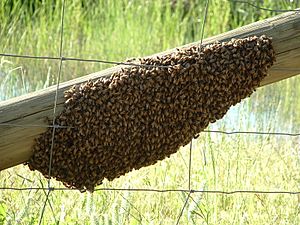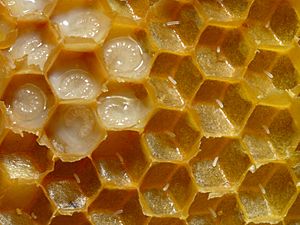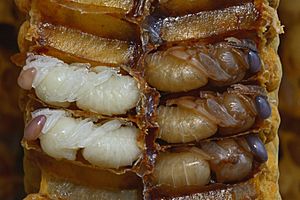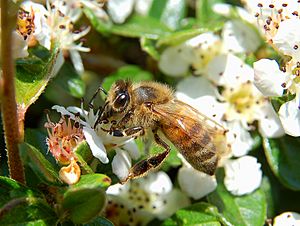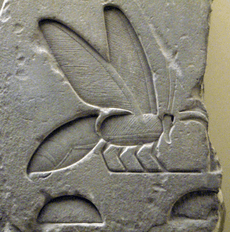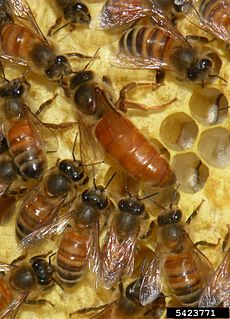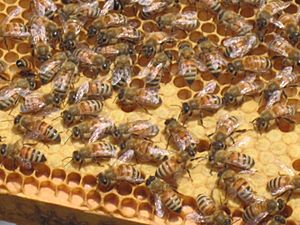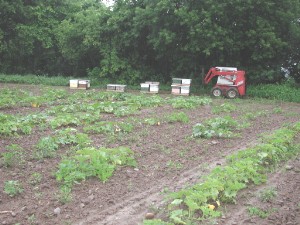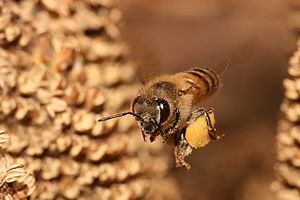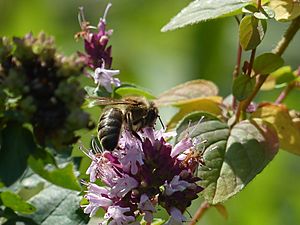European honey bee facts for kids
Quick facts for kids Western honey bee (Apis mellifera) |
|
|---|---|
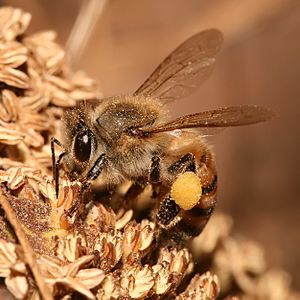 |
|
| Honey bee foraging on African Oil Palm flowers | |
| Scientific classification | |
| Kingdom: | |
| Phylum: | |
| Class: | |
| Order: | |
| Suborder: | |
| Superfamily: |
Apoidea
|
| Family: |
Apidae
|
| Subfamily: |
Apinae
|
| Tribe: | |
| Genus: | |
| Binomial name | |
| Apis mellifera Linnaeus, 1758
|
|
The European honey bee or western honey bee (Apis mellifera) is the main type of honey bee. The name Apis is Latin for "bee". Mellifera means "honey-bearing". So, the scientific name means "honey-bearing bee". In 1758, Carolus Linnaeus gave them this name. He later learned that bees carry nectar, not honey. He tried to change the name to Apis mellifica, meaning "honey-making bee".
Worker bees do a special "waggle dance" inside the beehive. This dance tells other bees where they found nectar. A scientist named Karl von Frisch discovered this amazing way bees talk to each other.
Contents
Where Western Honey Bees Live
Western honey bees live on every continent except Antarctica. Scientists think they first came from Africa or Asia. From there, they spread across Africa, the Middle East, and Europe. People helped them spread even more. Humans brought European honey bees to North America in the early 1600s. They also brought them to South America, Australia, New Zealand, and East Asia.
Western honey bees have learned to live in different places. For example, in cold places, they huddle together in winter to stay warm. In hot, dry areas, they are very good at finding food. These changes have led to 28 different types, called subspecies. All these types can still have babies together.
Honey Bee Biology and Life Cycle
How a Bee Colony Lives and Grows
Unlike most other bees, honey bee colonies live for many years. Because they are so social and long-lasting, a honey bee colony acts like one big living thing. When a honey bee colony reproduces, it does so by "swarming".
Most western honey bees swarm in spring and early summer. This is when many flowers are blooming, and there is lots of nectar and pollen. The hive makes many new queen bees. Just before these new queens are ready to hatch, the old queen leaves. She takes about two-thirds of the adult worker bees with her. This group, called a swarm, flies off to find a new home. They might find a hollow tree trunk or another good spot.
Back in the old hive, the new queen bees start to make sounds. When they hatch, they fight each other until only one queen is left. If one queen hatches before the others, she might kill her sisters while they are still developing. The queen who wins becomes the new queen for the old colony.
The new queen is the only fertile female bee. She lays all the eggs for the colony her mother left behind. She needs to mate to produce female bees, which make up most of the colony. So, the new queen takes one or more "nuptial flights". She mates with many male bees, called drones, during these flights. After mating, usually within two weeks, she stays in the hive and lays eggs.
During the warmer months, the colony makes many worker bees. These workers gather pollen and nectar to get ready for winter. A healthy hive in summer can have 40,000 to 80,000 bees! Worker bees turn nectar into honey by drying it out. They cap the honey with wax, and it can be stored for a very long time.
In cold places, bees stay in their hive during winter. The queen might stop laying eggs. The colony eats its stored honey to stay warm. In late winter, the queen starts laying eggs again as the days get longer.
How an Individual Bee Grows
Like other insects that change completely, the western honey bee has four life stages: egg, larva, pupa, and adult. All these stages happen at the same time in a hive for most of the year. The queen lays one egg in each cell made by worker bees. The egg hatches into a larva, which is like a tiny worm without legs or eyes. "Nurse" bees, who are young worker bees, feed the larva.
After about a week, the nurse bees seal the larva in its cell. It then becomes a pupa. After another week, it hatches as an adult bee. You can often see areas of the honeycomb filled with young bees, called "brood". Other areas are filled with pollen and honey.
Worker bees make the wax used to build the hive. They also clean, guard, and fix the hive. They raise the young bees and find nectar and pollen. A worker bee's job changes as it gets older. For the first ten days, workers clean the hive and feed larvae. Then, they start building comb cells. From day 16 to 20, they take nectar and pollen from older workers and store it. After day 20, a worker bee leaves the hive. It spends the rest of its life as a forager, collecting food.
Queens and workers have a special part called a stinger. They use it to protect the hive. Worker honey bees have a barbed stinger. This means it has tiny hooks. When a worker bee stings a human or other mammal, the stinger often gets stuck. It pulls away from the bee's body, and the bee usually dies. This is because the stinger is designed to stay in the skin to keep pumping venom. However, if a bee stings something with less elastic skin, like another insect, it can sometimes pull its stinger out and live.
A queen bee usually lives for three to five years. Some queens have lived up to eight years! As a queen gets older, she lays fewer fertilized eggs. Beekeepers often replace queens every year or two.
Worker bees live for different lengths of time. Workers born in spring and summer work very hard and live only a few weeks. But workers born in autumn can live for several months during winter. On average, about one percent of a colony's worker bees die each day. All the workers in a colony are replaced about every four months.
Bee Social Roles
Queens
The queen bee is a female bee that can have babies. She is bigger than worker bees and has a longer, rounder body. A female egg can become either a queen or a worker bee. For their first three days, both workers and queens eat "royal jelly". This is a special food high in protein. After three days, workers switch to a diet of pollen and nectar. Queens keep eating royal jelly. This special diet helps queens grow a healthy reproductive system, which is needed to keep the colony going.
Sometimes, the colony decides it needs a new queen. This can happen for three main reasons:
- The hive is full of honey, and there is not much space for new eggs. This causes the old queen to swarm. She takes about half the worker bees to start a new colony. The new queen stays with the other half of the workers in the old hive.
- The old queen starts to get weak. The bees notice she is not making enough special queen smells (pheromones). This is called "supersedure." The old queen is usually killed after the new one is ready.
- The old queen dies suddenly. This is called "emergency supersedure." Worker bees find some young eggs or larvae and try to turn them into queens. You can tell this happened because the new queen cells are built from regular comb cells, not hanging from the bottom of the frame.
No matter the reason, workers feed the larvae royal jelly to make them into queens.
Queens are not raised in the usual flat cells of the honeycomb. A queen cell is bigger and hangs down vertically, looking a bit like a peanut. When workers feel an old queen is weakening, they build these special emergency cells. When the queen finishes growing and becomes a pupa, she moves head-down. Later, she chews her way out of the cell. Workers seal the cell when she is a pupa. The queen controls the worker bees by releasing special smells called queen scent.
After a few days of getting used to the hive, the young queen flies to a special place. This place is called a "drone congregation point." It's usually an open area about 30 feet (9 meters) above the ground. Male bees, called drones, from different hives gather there. They smell the queen, find her by sight, and mate with her in the air. A queen will mate many times, sometimes over several days, until she has enough sperm stored.
The queen lays all the eggs in a healthy colony. How many eggs she lays depends on the weather, how much food is available, and the type of bee. Queens usually slow down egg-laying in early fall and might stop in winter. Egg-laying starts again in late winter as days get longer and is highest in spring. At the busiest time, a queen can lay over 2,500 eggs each day!
She fertilizes each egg with stored sperm when she lays it in a worker-sized cell. Eggs laid in larger, drone-sized cells are not fertilized. These unfertilized eggs have half as many genes as queen or worker eggs and grow into drones.
Workers
Workers are female bees that cannot have babies. They come from fertilized eggs. Workers are super important for the colony to work well. They do most of the jobs in the hive because the queen only focuses on laying eggs. These female bees raise their sister workers and future queens. They also go out to find nectar and pollen and bring it back to the hive to feed the young bees.
Drones
Drones are the male bees in the colony. They do not have stingers. Drones do not collect nectar or pollen. Their main job is to fertilize a new queen. Many drones will mate with a queen during her flight. Each drone dies right after mating. Drone honey bees have only half the genes of the queen or worker bees. They get all their genes from their mother, the queen. In cold places, drones are usually kicked out of the hive before winter. They die from cold and hunger because they cannot find food or take care of themselves.
Bee Behavior
Staying Warm
A honey bee needs its body temperature to be about 95°F (35°C) to fly. This temperature is also kept in the nest for the young bees to grow. It is also the best temperature for making wax. In winter, the temperature inside the bee cluster can be as low as 68-72°F (20-22°C).
Honey bees can fly and find food in temperatures ranging over 30°F (17°C). They have ways to control their body temperature. When it's cold, they shiver before flying. When it's hot, they cool down by spitting out a tiny drop of warm fluid from their honey stomach. This cools their head by about 10°F (5.5°C).
The best temperature for bees to find food is 72-77°F (22-25°C). Below 45-50°F (7-10°C), bees cannot move. Above 100°F (38°C), their activity slows down. Honey bees can handle temperatures up to 122°F (50°C) for short times.
How Bees Communicate
People have studied how honey bees communicate a lot. Karl von Frisch, who won a Nobel Prize, found that bees talk through dancing! When a worker bee comes back to the hive, its dance tells other bees about food. The dance shows how far away the food is, where it is, and in what direction.
Honey bees use two main dances: the round dance and the waggle dance. The round dance tells other bees that food is within 50 meters (164 feet) of the hive. But it doesn't say much about direction. The waggle dance gives more details about both distance and direction. Bees also use their sense of smell to find the food after the dances.
Another way bees communicate is with the "shaking signal." A worker bee vibrates its body while holding another bee. This signal is often used by experienced foragers. It can tell other bees to become more active or, sometimes, to slow down. All these ways of talking help honey bees find food and manage their tasks.
Pheromones
Pheromones are special chemicals that bees use to communicate. They are super important for honey bees to survive. Honey bees use pheromones for almost everything they do. This includes mating, giving alarm signals, defending the hive, finding their way, recognizing their family and colony, making food, and working together.
Honey Bee Domestication
The honey bee is one of the few invertebrate animals that people have tamed. People collected wild honey thousands of years ago. There are rock art pictures from France and Spain, about 8,000 years old, showing honey hunting. Bees were probably first tamed in ancient Egypt. Pictures in tombs show beekeeping. Bees were brought to North America in 1622.
Beekeepers have chosen bees with certain good traits:
- Being able to live when there is little food.
- Being able to survive cold weather.
- Being strong against diseases.
- Making more honey.
- Being less aggressive.
- Not swarming as often.
- Building fewer nests outside the hive.
- Being easy to calm with smoke.
These changes have made bees better for beekeepers. But it has also made bees more dependent on people to survive.
Beekeeping
The honey bee is a social insect that beekeepers keep, feed, and move. Honey bees cannot live or have babies alone. They only survive as part of their colony, which acts like a superorganism.
Honey bees collect nectar from flowers and turn it into honey. They store the honey in the hive. Bees carry nectar in a special stomach. Worker bees add enzymes to it and store it in honey cells to dry. Nectar and honey give bees energy for flying and for heating the hive in winter. Honey bees also collect pollen. Pollen provides protein and fat for the young bees, called bee brood, to grow.
For hundreds of years, people have chosen bees that make much more honey than they need. Beekeepers, also called apiarists, collect this extra honey.
Beekeepers give the colony a place to live and store honey. There are different types of beehives. Modern hives let beekeepers move bees from one farm to another. This helps crops get pollinated, which is a way beekeepers earn money.
In cold places, some beekeepers move their colonies indoors for winter. This protects the bees from extreme cold. But it can also lead to problems like too much carbon dioxide from the bees breathing. Canadian beekeepers have improved indoor wintering by using large barns with special air systems.
Products from Honey Bees
More Honey Bees
One main product of honey bees is more honey bees! People buy honey bees as mated queens, or in packages with a queen and workers, or as small colonies. Buying and selling bees has happened since ancient times. Modern ways of raising queens and dividing colonies started in the late 1800s. Bees are often raised in warm places and sold to colder areas.
Pollination
The most important commercial value of honey bees is that they pollinate crops. Farms have grown bigger, but wild pollinators have become fewer. So, beekeepers move their hives to farms when crops are blooming. This helps the plants grow fruit and seeds. For example, in California, honey bees are needed to pollinate almond trees in February. This is the biggest managed pollination event in the world. It uses more than one-third of all managed honey bees in the United States. Bees also help pollinate apples, blueberries, and many other crops.
Honey
Honey is a sweet, thick substance made by honey bees from nectar. Bees gather nectar, change it with enzymes, and store it in the comb. Honey is mostly sugars like glucose and fructose. It can stop bacteria and fungi from growing. Honey does not rot or go bad when stored normally, but it can turn solid over time. Bees can only use liquid honey.
Bees make honey by collecting nectar, which is mostly water and sugars. The collecting bees store nectar in a second stomach. They bring it back to the hive, where worker bees take it. Worker bees digest the nectar for about 30 minutes, breaking down the sugars. Then, they spread the honey in empty honeycomb cells to dry. They fan their wings to create a draft and reduce the water in the honey to less than 20 percent. When the honey is dry, they seal the cells with wax to keep it fresh.
When a hive senses smoke, many bees become calm. This is thought to be a defense. Wild colonies often live in hollow trees. If they smell smoke, they might think there's a forest fire. They quickly eat as much honey as they can, getting ready to leave. When they are full of honey, they are usually gentle.
Beeswax
Older worker bees make beeswax from glands on their bodies. They use this wax to build the walls and caps of the honeycomb. When honey is collected, the wax can be gathered. It is used to make things like candles and seals.
Pollen
Bees collect pollen in a special "pollen basket" on their legs. They carry it back to the hive. Pollen is a source of protein for raising young bees. Extra pollen can be collected from the hive. Some people eat bee pollen as a health supplement, but it can cause allergic reactions in some people.
Propolis
Propolis is a sticky, resin-like mix that honey bees collect from tree buds and other plants. They use it to seal unwanted open spaces in the hive. Some people believe propolis has health benefits, but it can cause severe allergic reactions in some individuals. Propolis is also used in wood finishes.
Royal Jelly
Royal jelly is a special food made by honey bees to feed their larvae. It is especially important for queen larvae. It is also sold for its supposed health benefits, but it can cause severe allergic reactions in some people.
Honey Bee Genes
In 2006, scientists fully studied the genes (DNA) of Apis mellifera. Since 2007, there has been a lot of focus on "colony collapse disorder". This is when many European honey bee colonies disappear in different places.
The European honey bee was the third insect to have its genes mapped. Scientists found that honey bees have more genes for smell than for taste. They also have fewer genes for fighting off sickness compared to fruit flies or mosquitoes. The study also showed that some of the honey bee's genes, like those for daily rhythms, are more like those of animals with backbones than other insects.
Dangers and Survival
European honey bee populations face dangers. This has made people more interested in other pollinator bees. In the early 1990s, many bees in North America and Europe were lost because of varroa mites. In 2006 and 2007, beekeepers in the US also faced colony collapse disorder. Better beekeeping methods and treatments for varroa mites have helped most commercial beekeepers. New types of bees are also helping reduce the need for mite treatments. Wild bee populations were greatly reduced but are slowly coming back. This is because some bees are naturally resistant to varroa mites. Insecticides, especially when used too much, have also harmed bee populations. Bee pests and diseases are also becoming resistant to medicines.
Dangers from the Environment

Africanized bees have spread across the southern United States. They can be a slight danger to humans, making beekeeping harder. In places where they are not native, wild honey bees can cause problems. They might take over from native bees and birds. They can also help spread invasive plants that native pollinators ignore. Unlike native bees, honey bees are not good at collecting pollen from certain flowers.
Animals That Hunt Bees
Many animals hunt honey bees:
- Insects: The Asian giant hornet, other wasps, robber flies, dragonflies, the European beewolf, some praying mantises, and the water strider.
- Spiders: Fishing spiders, lynx spiders, goldenrod spiders, and the St Andrew's Cross spider.
- Reptiles and Amphibians: The American toad, Anole lizards, the American bullfrog, and the wood frog.
- Birds: Bee-eaters, grackles, hummingbirds, and tyrant flycatchers.
- Mammals: Bears, least shrews, opossums, raccoons, honey badgers, and skunks.
Images for kids
See also
 In Spanish: Abeja europea para niños
In Spanish: Abeja europea para niños



